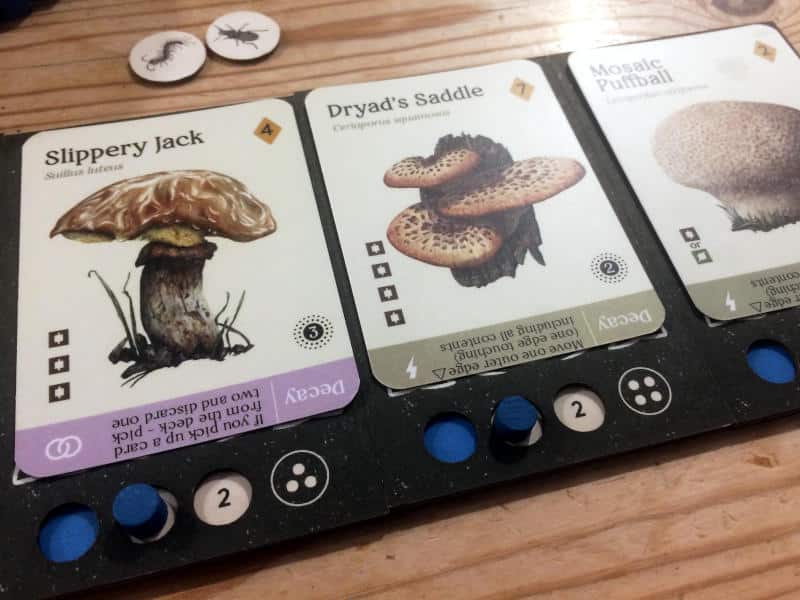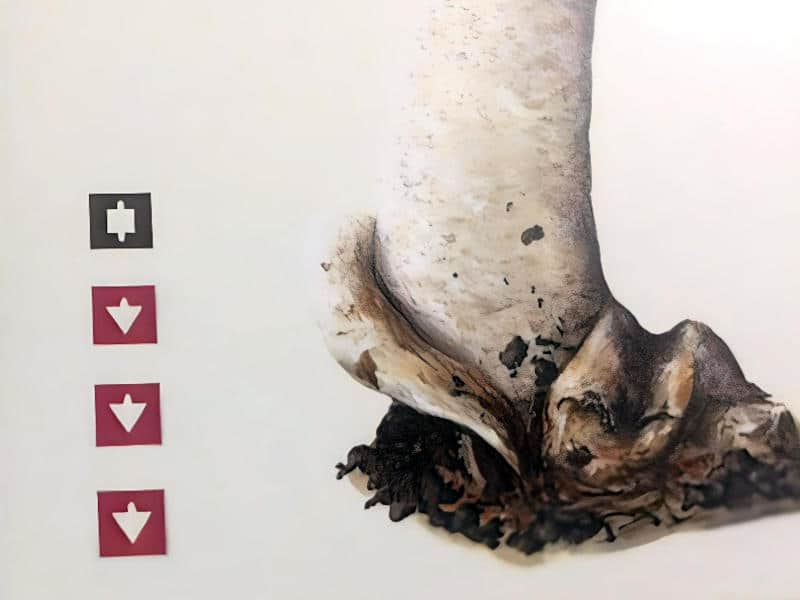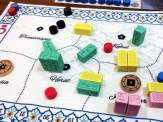| Release Date: 2024 | Players: 1-4 |
| Designer: J. J. Neville | Length: 45-90 minutes |
| Artist: J. J. Neville | Age: 10+ |
| Publisher: Split Stone Games | Complexity: 2.0 / 5 |
| Plastic (by weight): n/a | Air (by volume): n/a |
Fungi have long been misclassified as plants. In reality, they are a whole kingdom of their own. What we call a mushroom is just a fungus’s fruit that appears above ground, but a mushroom is just a tiny part of a fungus. It’s their underground root system composed of dense masses of fine, thread-like filaments, called hyphae, that makes up the majority of a fungus. Yet, mushrooms are crucial in a fungus’s propagation. Mushrooms send out spores, which are carried through the air to new locations. When they eventually germinate they create new Mycelia by J. J. Neville from Split Stone Games.
Listen to the Audio Version
Intro Music: Bomber (Sting) by Riot (https://www.
Music: Respect Ambient Relaxed by EdiKey20
Free download: https://filmmusic.io/song/8407-respect-ambient-relaxed
Licensed under CC BY 4.0: https://filmmusic.io/standard-license
Let me start this review by saying that I was given a prototype of Mycelia. So what you see in the photos are not the final components. You do get a good idea of the artwork and overall visual style of what the game will eventually look like. You can also see that the game’s component quality is going to be high, featuring dual-layer boards for example. The game itself is virtually complete. The rulebook is being tweaked for clarity and readability, but the rules are practically finished. So, I am confident that my impressions of the prototype I played and how the game, which will be available once the crowdfunding campaign is complete, will feel like, are going to be the same.
Spore and Spread Your Mycelia
In Mycelia, you are a colony of mushrooms. You send out spores in the hope that they germinate to establish new mycelia, which will eventually fruit into new mushrooms. Spores spread in a random wind direction and land on different tiles, representing different types of food sources.
The land area is made up of triangles in four different colours: three different food types and a wildcard one that can be used as a food type of choice. The game starts with a certain number of tiles randomly set up, but during play, you can add more triangles to extend the available space for your and the other players’ mushrooms to spore into.
Once you have established enough spores on different tiles, you can start fruiting them into new mushrooms. That’s one part of Mycelia I really like. Spores represent your resources and depending on what colour triangle they are on, they represent different types of resources. When you fruit a new mushroom, you need a certain colour combination and a specific number of these spores. However, spores that are on neighbouring tiles form a network that could stretch across the whole land. You can pick spores from any of the triangles in this network to fulfil the resource requirements of the mushroom you want to fruit. You then place the new mushroom on any of the tiles you took spores from.
Fruiting a new mushroom can seem a bit confusing at first, but it’s a key element that makes Mycelia so interesting. The bigger your network of spores, the more options you have. At the same time, you can also have several different spore networks and still be able to fruit new mushrooms. The game tries to emulate real mycelia networks.
Area Control
At this stage, it sounds like Mycelia is all about area control, but that’s not really true. Spores can co-exist and having spores on a piece of land doesn’t mean you now control that triangle. It is actually the mushrooms that exert control over a tile. There can ever be only one mushroom in the same triangle, except for the so-called mother mushroom, but more about that later. So it’s the mushrooms that introduce the area control element to the game.
Mushrooms can also interrupt spore networks. As we heard just now, the bigger your spore network, the more choice of mushrooms you can fruit. So, breaking the chain of another player’s spores can be really disruptive. Not only that, mushrooms also control all spores on a triangular tile, including those from another player. So if you can manage to stretch your mycelia into a space full of another player’s spores and then fruit your own mushroom there using your own spores, you suddenly get access to a whole stash of resources that another player painstakingly established.
So, yes, there is a lot of negative player interaction in Mycelia. That’s not where it ends though, but let me explain something else first.

Moving Mother Mushrooms
As you would imagine, mushrooms don’t move. Once fruited, they stay in place until they eventually decay. Spores, as you would expect, float on the air and disperse, but once they have landed, they stay there. There is one thing that can move though and that’s the mother mushroom. I know, that makes no sense. I’m not sure what the mother mushroom actually represents, other than maybe some sort of spiritual force that can move around. What’s clear though is that the mother mushroom is crucial to get your engine going and get you out of a tight spot.
Your mother mushroom can send out spores, like any other mushroom, but it can also move. At the same time, it functions like a normal mushroom, which means it controls a tile and the spores on it. If you can move your mother mushroom to another player’s spores, you can fruit one of your own mushrooms there. Normally two mushrooms can’t be on the same tile, but you can have a mother mushroom and a normal mushroom together.
In fact, a mother mushroom suppresses a normal mushroom from another player, preventing it from sporing or even decaying. Mother mushrooms are very powerful, but quite slow. Getting them to where you want them to be, can take a few turns – and that’s where the other, even meaner, type of player interaction comes in. If you have two insects, which are another type of resource in Mycelia, you can move another payer’s mother mushroom to anywhere on the board. That’s very harsh and even allows you to place them in a corner where they’re blocked.
Survival of the Fittest
Personally, I quite like this level of player interaction, but I know it’s not for everyone. I feel it wonderfully emulates the principle of Survival of the Fittest. What seems like a calm, peaceful world of beautiful mushrooms and their spores floating on a gentle breeze is really all about spotting opportunities and pouncing on them.
The game starts out relatively slow and monotonous. However, each mushroom you fruit is represented by a card that costs a certain number and combination of resources from your spores, but once that mushroom has decayed, which happens after it has spored twice, it will give you either a permanent bonus or a one-off, powerful action. So timing when you fruit your mushrooms and when you decay them is important. Where you fruit them is also something you should carefully think about.
Every player has five normal mushrooms they can have on the board at the same time, so it can get quite busy unless you extend the play area with new triangular tiles. As mushrooms decay, players slowly build an engine and the game starts to ramp up.
Each mushroom also represents a certain number of victory points, with more valuable ones requiring more spores, but also often giving more powerful bonuses. You can draw new mushroom cards from an offer row for free, so keep an eye on those.
You also need to keep an eye on how many points other players have. The game is over when one player has decayed all of their five mushrooms at least once. So you have some level of control over whether you want to rush the end or try and drag it out a few more turns to catch up.

Gorgeous Mushrooms
The game is really interesting and fun to play, even though there are still some rough edges in the gameplay. The illustrations are absolutely gorgeous and Mycelia has a real table presence, even in prototype form. If the final product looks at least this good, you’re in for a real treat. The dual-layer player boards are great and really enhance some of the key parts of the gameplay, for example.
One niggle I found is the choice of colours. Two of the three triangle colours are quite similar and all of them are rather pastel-looking. Every colour is also represented by a symbol, but these are really small and certainly on the mushroom cards, they are hard to see. So bear that in mind.
Overall, Mycelia is a really interesting game and does a couple of clever things that I’ve not seen before. The concept of spore networks, for example, makes for a really interesting mechanism. I also like the end-game trigger, which can lead to situations where one player’s mother mushroom suppresses another player’s so that they can’t decay it and end the game.
So, if you like mushrooms and don’t mind a hefty amount of negative player interaction, then I strongly suggest you give Mycelia a closer look.
This blog is free for everyone, but if you'd like to support it, here are some options.
Useful Links
- Mycelia: https://splitstonegames.
com/ - Split Stone Games: https://splitstonegames.
com/ - BGG listing: https://boardgamegeek.
com/ boardgame/ 378476/ mycelia - Kickstarter page: https://www.
kickstarter. com/ projects/ splitstonegames/ mycelia-the-strategic-mushroom-board-game
Videos
Transparency Facts
I feel that this review reflects my own, independent and honest opinion, but the facts below allow you to decide whether you think that I was influenced in any way. Please also read my Ethics Statement for more information.- I was given a free review copy of this game by the publisher.
- At the time of writing, I have not received financial support from the publisher or anyone working on their behalf.
Audio Version
Intro Music: Bomber (Sting) by Riot (https://www.
Music: Respect Ambient Relaxed by EdiKey20
Free download: https://filmmusic.io/song/8407-respect-ambient-relaxed
Licensed under CC BY 4.0: https://filmmusic.io/standard-license
Playlist
These are the songs I listened to while I was writing this review:






